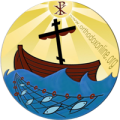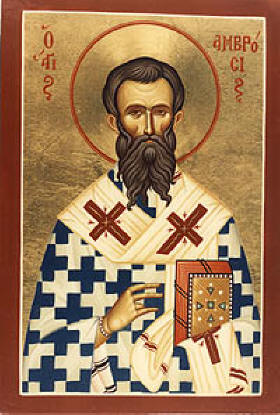child  Saint Ambrose, Bishop of Milan in France in the year 340. He was a great teacher of high culture and a preaching orator who was able to imitate hearts and minds. Emperor Valentianus appointed him governor after he finished studying law, and he was one of the men of the Shura Council in Rome. Because of his meekness, the people of the church in Milan chose him as their bishop while he was still ruling. But he objected to this choice, and the people did not accept his objection, so he submitted to their will and the will of God, and was ordained a bishop when he was 43 years old on December 7, 374. The first thing he did after that was that he distributed his money to the poor and lived in extreme austerity. Bishop Ambrose left several works in Latin explaining the Holy Bible, the mysteries, and Christian morals, and composed some church hymns. He fell asleep in Christ on the day of the Easter Offering, April 4, 397. The Church celebrates him on the seventh of December.
Saint Ambrose, Bishop of Milan in France in the year 340. He was a great teacher of high culture and a preaching orator who was able to imitate hearts and minds. Emperor Valentianus appointed him governor after he finished studying law, and he was one of the men of the Shura Council in Rome. Because of his meekness, the people of the church in Milan chose him as their bishop while he was still ruling. But he objected to this choice, and the people did not accept his objection, so he submitted to their will and the will of God, and was ordained a bishop when he was 43 years old on December 7, 374. The first thing he did after that was that he distributed his money to the poor and lived in extreme austerity. Bishop Ambrose left several works in Latin explaining the Holy Bible, the mysteries, and Christian morals, and composed some church hymns. He fell asleep in Christ on the day of the Easter Offering, April 4, 397. The Church celebrates him on the seventh of December.
Saint Ambrose was distinguished in his pastoral explanation of the Holy Bible, as he used to give this explanation to believers from all social strata during prayer in the church, and his goal was for Christ to reach them so that they would follow the path of repentance. In his explanation of the Gospel of Saint Luke about the incident of Saint Peter’s denial of Christ and then his repentance (Luke 22: 56-62), Bishop Ambrose says: “Peter was sad and wept because of the mistake he had committed. I did not find in the holy books that he uttered any word, but I read in them that he cried. I did not read his apology in it, but rather I read his tears.” Ambrose continues his comment on this Gospel passage by saying: “Those who cry are the ones whom Christ looks to. Peter denied him for the first time and did not cry because the Lord had not looked at him. He denied him a second time and did not cry because the Lord had not looked at him yet. The third time, he cried bitterly because Christ looked at him after his denial. Here the Gospel text says: “Then the Lord turned and looked at Peter, and Peter remembered the words of the Lord...” (verse 61). Ambrose ends his meditation by praying: “Lord Jesus, look at us so that we too may learn to weep over our sins.”
 Ambrose wrote an essay on faith in which he considered that practicing faith is much more important than arguing about it: “The encouragement to faith lies in bearing witness to it, while the debate about it is not devoid of arrogance.” He wrote another article in which he addressed the issue of the Holy Spirit. Inspired by the Greek fathers of his contemporaries, he emphasized the unity of essence between the Father, the Son, and the Holy Spirit. He also wrote an article in which he emphasized the incarnation of the Word and his divinity. In another place, he clearly declares his faith, saying: “Christ was born of the Virgin, and he proceeded from the Father, and he is with the Father and in the Father.” Begotten, not created, not separated from the Father. He is the Beloved, true God from true God.” Of course, the author of the text recalls the Constitution of Faith with additions that place the reader in a personal relationship with the Lord Jesus, not merely in reciting a doctrinal confession of faith.
Ambrose wrote an essay on faith in which he considered that practicing faith is much more important than arguing about it: “The encouragement to faith lies in bearing witness to it, while the debate about it is not devoid of arrogance.” He wrote another article in which he addressed the issue of the Holy Spirit. Inspired by the Greek fathers of his contemporaries, he emphasized the unity of essence between the Father, the Son, and the Holy Spirit. He also wrote an article in which he emphasized the incarnation of the Word and his divinity. In another place, he clearly declares his faith, saying: “Christ was born of the Virgin, and he proceeded from the Father, and he is with the Father and in the Father.” Begotten, not created, not separated from the Father. He is the Beloved, true God from true God.” Of course, the author of the text recalls the Constitution of Faith with additions that place the reader in a personal relationship with the Lord Jesus, not merely in reciting a doctrinal confession of faith.
One of the most important works of Saint Ambrose is a book from a collection of sermons on the sacraments, which the writer addressed to the newly baptized in which he explains to them the mystery of baptism, the mystery of chrismation, and the mystery of thanksgiving (the Divine Mass). In these sermons, the author presents a teaching filled with biblical and liturgical symbols about the connection of the sacraments with the Resurrection. It should be noted here that baptism was performed during the Easter season, especially on the day of Holy Saturday (Holy Saturday), and this is further evidence of the extent to which baptism is linked to the death and resurrection of Christ.
Ascetic writings occupy a prominent place in the writings of Saint Ambrose, as he wrote several articles on the importance of virginity. Ambrose comments on the incident of Christ’s appearance to Mary Magdalene (John 20: 1-18) after his resurrection, saying: “Woman, why do you cry? Who are you asking for? Don't you see Christ? Just believe and you will see Him. Christ is close to you. He does not fail those who seek Him.” He continues his reflection, saying: “You are mistaken when you think that someone took Christ (from the grave). Don't you know that he rose with his own strength? No one can snatch Christ from the heart of those who love him.” Here we notice that Ambrose searches in the Gospel text for a spiritual meaning that benefits believers, and is not satisfied with a purely scientific explanation without pastoral lessons that make the listener also concerned with the words of the Gospel.
Saint Ambrose was a wise shepherd of the Church of Christ, and the repentance of believers meant a lot to him. It was said about him that he used to cry when he was listening to the confession of one of the believers, which made them cry as well.
We must adhere to what Saint Ambrose said, commenting on the conversation that took place between Christ and Mary Magdalene after his resurrection. He said: “When Mary was unaware of Christ, he called her, ‘Woman,’ and when she looked at him, he called her, ‘O Mary.’” Then the writer addresses Mary Magdalene, saying: “You have taken the name Mary, who gave birth to Christ, because you also gave birth to him spiritually.” Christ is born in every soul that yearns for Him. Let us celebrate Christmas with this hope.
The deeds of truth have shown your flock a law of faith, an image of meekness, and a teacher of abstinence, Father High Priest Ambrose. Therefore, by humility you have achieved exaltation and by poverty, wealth, so you intercede with Christ God to save our souls.

